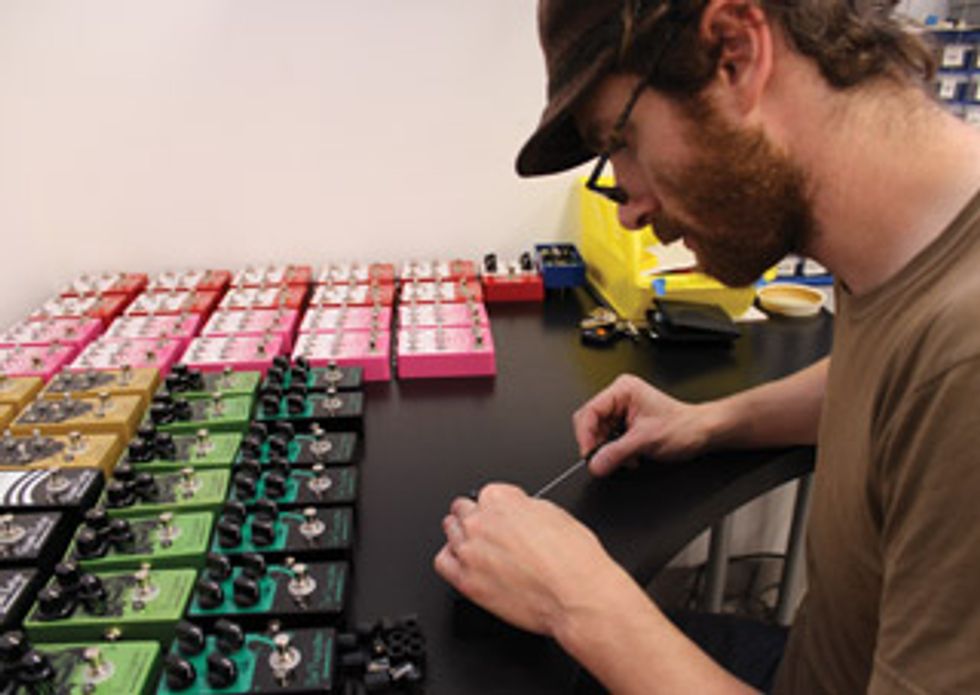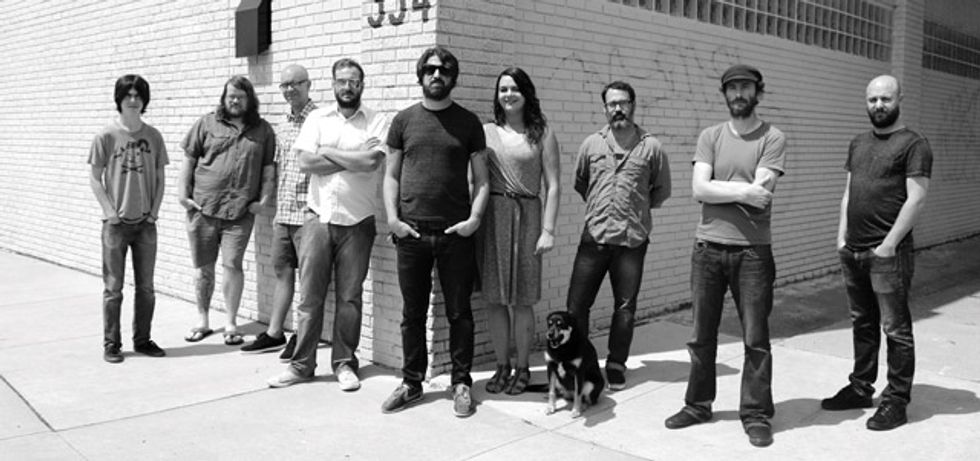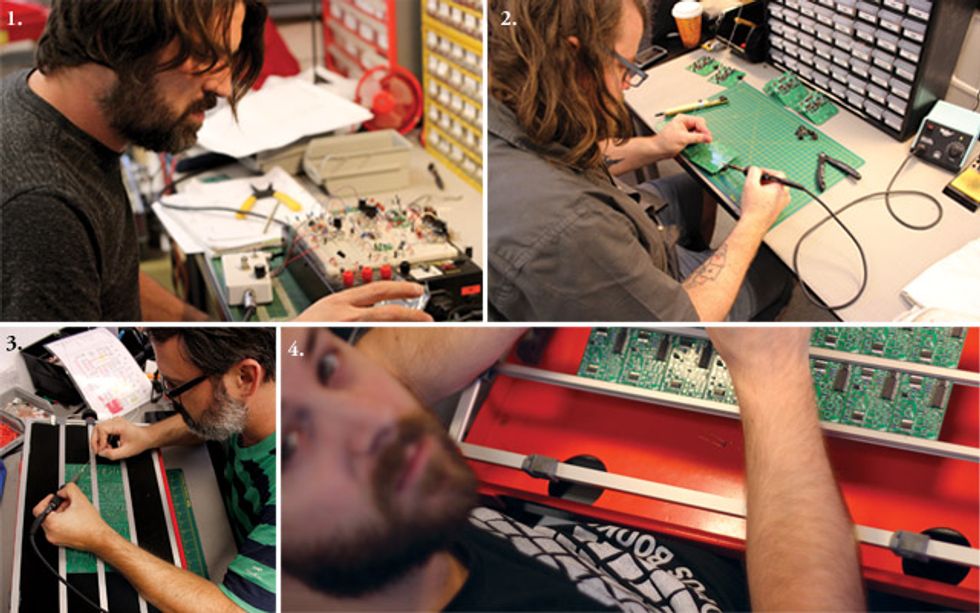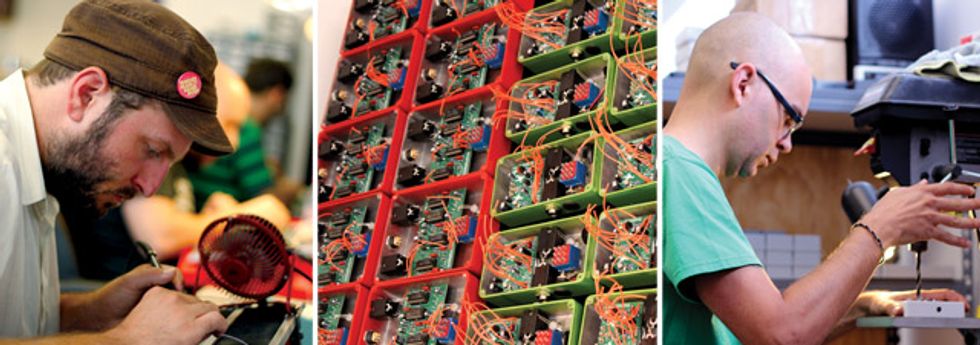EarthQuaker HQ: (L to R) Gavin Smith, Ben Veehorn (circuit builder), Mike Stangelo (PCB population, wires, assembly), Steve Clements (circuit builder),
Jamie Stillman (founder/pedal designer), Julie Robbins (business manager), Elsa (support), Justin Seeker (senior circuit builder) Jeff France (production
manager), Brad Thorla (assembly). Photo by Stephanie Falk
“Affordable” is not a word often associated with boutique effect pedals. Nor is Akron, Ohio, normally associated with bands that fill Madison Square Garden. But while Akron’s Jamie Stillman was road managing just such a band—the Black Keys—he was simultaneously starting a line of great-sounding, handwired boutique pedals that would retail for little more than those of the mass-produced variety.
Despite boasting some deliciously cryptic names (Grand Orbiter, anyone?), Stillman’s effects often tend toward the meat-andpotatoes variety—boost/EQ, delay/reverb, fuzz, modulation, octave, and overdrive. But Stillman certainly has his own take on these stalwarts, often pushing the limits of their parameters on both ends.
Inspired by Electro-Harmonix founder Mike Matthews’ screw-the-noise-if-it-sounds-great MO, Stillman has likewise proven his mettle as both a designer and manufacturer: His EarthQuaker Devices stompboxes are as appealing to junkies on pedal forums as they are to those more worried about how their purchase will affect their pocketbooks. His is a classic entrepreneurial success story, with worthwhile lessons about carefully monitoring growth while staying true to your vision.
How did you get started
building pedals?
Around 2004, I had a DOD
Overdrive/Preamp 250 that I
loved. When the volume pot
broke, I decided I would just
replace it. I opened it up and
discovered there was nothing
much in it. I found the schematic
online and, for some
reason, it just made total sense
to me—so I decided to build
a new one. During my search
for the schematic, I found
websites like geofx.com and
generalguitargadgets.com and
got obsessed. I would stay up for
days reading about electronics—
I was constantly going to forums
to learn as much as possible.
Did you have any technical
background?
None, but I am able to understand
schematics like any
electrical engineer. Put me in
front of a microwave oven, and
I doubt I could rebuild it. But
put me in front of an effect,
and I can work on it. I can
also work on some amps and
guitars. I have been a tinkerer
my entire life. My folks have
photos of me taking apart an
abandoned car in the backyard
when I was in kindergarten. I
was always dismantling things
around my grandparents’ house.
What’s your musical
background?
I have been a musician forever.
I started on drums when I
was 5 or 6, and I started playing
guitar when I was 10 or
11—about 20 years ago. Until
about two years ago, I had
spent pretty much my entire life
touring in indie-rock bands—
from age 17 until 33. I played
drums in Harriet the Spy, and
guitar in Party of Helicopters.
More recently, I was in a band
called Teeth of the Hydra, and a
band called Drummer with Pat
Carney from the Black Keys. I
am currently in a band called
Relaxer. I also worked as a freelance
graphic designer and as
tour manager for the Black Keys
from 2004 to 2010—but any
spare second was spent learning
about electronics as they relate
to musical instruments.
Were you working on Dan
Auerbach’s equipment when
you were with the Black Keys?
I was not a true guitar tech—I
didn’t string guitars or anything
like that—but I helped
set up the equipment and
handled emergencies. I also built
tons of pedals for Dan. The
EarthQuaker Hoof Fuzz is based
on his green Russian Big Muff.
What was your next project
after the DOD clone?
I then started with the standards.
I built a Fuzz Face clone,
but I had to build that one 50
times to get it to work right
[laughs]—[it was, like] “The
first one was so easy, why is this
one so hard?” That taught me a
lot about transistor biasing and
how something so simple can
be such a pain in the ass.
Fuzz pedals are notoriously
difficult to get right—even
for experienced builders.
From the sound of the Dream
Crusher, it seems like you
eventually nailed it.
When you get them right,
they are awesome. The Dream
Crusher was my version of the
Fuzz Face. I try to get as much
range as possible out of the
fuzz and dirt pedals we make,
and while I’m in there I end up
cleaning them up. They are not
as gritty as a lot of other distortion
pedals, and I like that.
After that, I started building all kinds of things. I took pieces from one circuit and attached them to another—all the weird, mad-scientist things everyone who gets into this kind of stuff does. I spent about a year messing with different circuits, and out of those came the three pedals I used to start EarthQuaker Devices. One was the Spectre Overdrive, which was basically a couple of JFET [junction gate field-effect transistor] boosters driving each other … it didn’t work out so well.
In terms of sound or sales?
It sounded pretty good, but at
the time I really didn’t know
what I was doing. We built four
of them and they all went to
friends, but the JFETs ended
up frying each other—I wasn’t
treating them properly. Looking
back, I see every stupid mistake I
made. The second pedal, the discontinued
Tusk Fuzz, ended up
being part of our line. It wasn’t
really based on any other pedal.
The third was the Hoof Fuzz,
and that really set it all off in
2005. I launched the company
on breaks from Black Keys tours.
I basically put a bunch of pedals
up on eBay and sold mostly
the Hoofs. It got around on the
forums that the Hoof sounded
good, and then people found out
I was working with the Black
Keys and that didn’t hurt.
1. EarthQuaker Devices Founder Jamie Stillman works on a pedal bread board. Stillman does all of the pedal designing
and screenprinting for his stompboxes. (Photo by Stephanie Falk) 2. Ben Veehorn works on early stages
of pedal building in the circuitboard workstation. (Photo by Jeff France) 3. Senior Circuit Builder Justin Seeker
working on Earthquaker Devices circuitboards. (Photo by Jeff France) 4. Brad Thorla works with circuitboards and
pedal assembly. (Photo by Jeff France)
When you started the company,
what did you feel you
could offer players that was
missing in pedals already on
the market?
When I started building, I had
no idea there was a world of
people online talking about
boutique pedals. I had always
used pedals but was never
happy with them. I heard
sounds made by other bands
and didn’t know how to get
them: I didn’t know that there
was a difference between the
sound of a Marshall JCM900
and a Marshall Super Lead,
or a Boss Overdrive versus a
Big Muff. I was unhappy that
I wasn’t getting the sound on
Led Zeppelin records, without
realizing I wasn’t using anything
close to the same gear. Once I
started building pedals, I realized
these are those sounds!
As I started experimenting with effects, I began adding things that I wanted, like more low end or more clarity, while still having the pedal sound like an amp on the verge of blowing up. Modern effects were clean, pristine, noise-free—sterile. My goal was to make things that sounded old and kind of [expletive] up. Noise was part of those old pedals, like Echoplexes and old fuzz pedals—they didn’t work right, and that’s what sounds so good. Over time, I realized I was trying to mix old and new to come up with the sound that I had in my head. It turned out other people were into that sound, too. I read the Analog Man book interview with Mike Matthews of Electro- Harmonix, and a lot of his philosophies fall right in line with mine. If it does its job but there is some noise—[expletive] it.
You used to work as a graphic
designer—did you design the
EarthQuaker logo?
The octopus skull? No, I wish
I did. I redrew it a bit. The
octopus skull was a piece of clip
art that I cut out of this ’90s
punk-rock magazine called Crap
Hound, thinking I would use it
some day. When I started making
EarthQuaker Devices, I put
it on there and it became recognizable.
Still, I wish I had come
up with something of my own.
I ran across a guy who had a tattoo
of it—but not because of us.
He came across it on his own.
What’s your shop like?
I used to work alone out of
my basement, but by March of
this year we had seven people
working in 300 square feet. I
am an organization freak, so we
had things going up the walls
and stored on the ceiling. We
had used every square inch of
my basement, and it was time
to move. Now we have a shop
downtown with 2,000 square
feet that’s five minutes from
my house. We are in a couple
of rooms in a warehouse—with
windows [laughs]. It is a bombproof
fortress, most of it owned
by an Akron company that
builds bionic limbs. We have
run out of room there already.
Compared to other handwired
boutique pedals, your prices
are pretty affordable—almost
in line with mass-produced
effects. How do you do it?
Volume—we sell a lot of pedals,
mostly through stores and
distributors. At any given point,
we sell from one to five percent
direct. The pricing has always
worked out—from the time I
was doing it myself up until
now, with nine people and a
ton of expenses. The volume
kept increasing, and we’ve done
everything at the right time to
maintain that pricing. That is
not to say we don’t lose money
on some pedals. Some are not
making a profit, but I love
them so much I won’t get rid
of them.
LEFT: Steve Clements tends to the fi ner details, in the saudering of PCB population into pedals. Photo by Jeff France. CENTER: Pedals in the wiring stage at EarthQuaker headquarters. Photo by Jeff France. RIGHT: Mike Stangelo drills stomp switch holes into EarthQuaker Device pedals.
Photo by Jeff France.
When we started, the low prices turned some of the boutique buyers off because they assumed low price meant crap workmanship. But it is important to me to keep the effects affordable and keep making them by hand. Otherwise, what is unique about them? I think some boutique pedal buyers search out the most expensive pedals they can find, whereas we have crossed over to the general purchaser who walks into your average music store in the middle of Minnesota and says, “I want an overdrive pedal that does such and such.” The salesman shows them one of ours, and they go, “Oh, cool.” They might have come in looking for a Boss overdrive and they end up with one of our pedals. Then again, some of those people think our prices are a little high.
Do you take custom orders?
We used to, but we just can’t
keep up with it—I’m the only
one who can do custom stuff.
Most of the people who work
here do it like paint by numbers:
They get a build sheet
and they only know how to
build our pedals. If someone
wanted a purple Organizer [an
EarthQuaker pedal that produces
organ-like effects] with a
boost function, I would be the
only one who could do that—
and I don’t have the time.
We have hired more and more people, so actually building pedals has been out of my hands for a year, if not longer. My daily routine involves answering a ton of emails and fielding questions from everyone in the shop. My final hands-on thing with the pedals is hand-screening them and doing all the repairs. Sometimes we do custom colors for people because they happened to write us just when I was about to order enclosures, so I can throw in a one-off color. But in terms of fully custom pedals, I just don’t have the time— which sucks for me, because I like doing stuff like that. Occasionally, I will do a limited run of fuzz pedals because I like doing them.
Are you working on any new
pedal designs right now?
I haven’t had time lately to
design anything new, but I had
a lot of free time last year so I
have a backlog of ideas and prototypes
for new pedals.
Why EarthQuaker “Devices,”
rather than “Effects” or
“Pedals”?
It is my obsession with old
things—it sounds like an old
Japanese pedal company. It’s the
same reason I use “machine”
on the end of some of the
pedal names. I always thought
the old Foxx Tone Machine
name was really cool, or the
Hornby-Skewes Zonk Machine,
which is my favorite name for a
pedal—ever.
What kind of pedal was that?
I believe it was a treble booster
into a Fuzz Face. I’ve never seen
one, though.
Some EarthQuaker nomenclature
can be a little vague.
For example, is there any bit
reduction going on in the Bit
Commander synth pedal?
No—that confused everyone
at first. I was thinking in terms
of 8-bit sound as opposed to
a bit crusher. Maybe I should
have saved the name Bit
Commander for a bit crusher
pedal! [Laughs.]

Lastly, Production Manager Jeff France places knobs on the various pedals. Photo by Stephanie Falk
Is the Attack knob on the
Ghost Echo a predelay?
Yes. That is another one of
those confusing things that
makes total sense to me, but
when we first put it out people
were like, “What is this?” I like
to hover in the space somewhere
between reality and being totally
cryptic. About 50 percent of our
pedals don’t have instructions
for that very reason. Just plug it
in and mess around with it and
you will figure it out.
Was the White Light Overdrive
a reference to Lou Reed’s
“White Light, White Heat”?
No, I wish I were cool enough
to say it was—not that I was
unfamiliar with that song. I
seem to go through phases
when naming pedals. I was
coming off an animal phase and
moving into a short-lived color
phase with that pedal.
Why would you call an amazingsounding
fuzz Dream Crusher?
My wife named that.
Because you spent time
designing it instead of taking
her to dinner?
Yeah, right. I think I had the
graphic before we had the
name. It is based on the skull
inside the dream catcher.
It seems a little pessimistic to
call your delays—the Disaster
Transport and Disaster
Transport Jr.—“disasters”?
Dispatch Master [reverb/delay]
and Disaster Transport are
both Ohio references. Disaster
Transport is the name of a roller
coaster here at Cedar Point
[amusement park in Sandusky].
It was called Dispatch Master
Transport, but after an explosion
knocked off some of the
letters it read “Dis … aster
Transport.” Coincidentally, that
ride just shut down.
Tell us about the new
Talons pedal.
It is an overdrive that goes from
totally clean to full-on distortion,
with a fully active boost
EQ and a presence knob to
tame that last bit of high end. It
really covers a lot of ground—it
does a lot more than most
overdrive pedals I’ve played. I’m
really happy with it, and it takes
a lot for me to be happy with an
overdrive. I went through eight
completely different circuits.
Ironically, the end result was the
easiest circuit to work with.
How much of any given
design is based on customer
feedback?
Not a lot. You can’t please
everybody. I will sometimes
listen to our production manager,
Jeff France. He will come
up with ideas for additions
and subtractions, and he will
bluntly tell me if an idea sucks.
Ninety-five percent of the time
I go with my ideas, and five
percent will be his suggestions.
We get emails with suggestions,
but everyone who works here—
especially my wife—will tell you
I am very set in my ways and
usually use only my own ideas
[laughs].






























